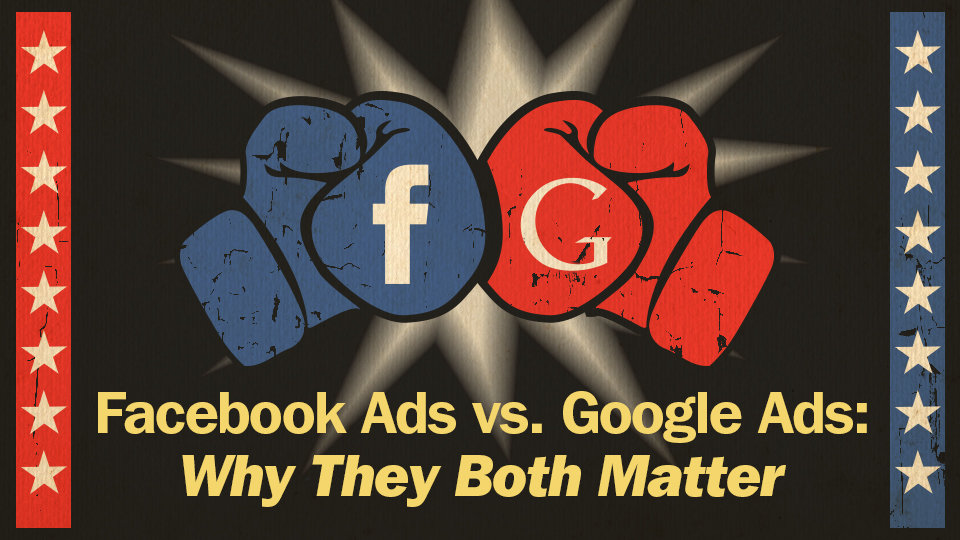When to Use Facebook Ads Vs. Google Ads?
By Kristen Shoates
By now, we all know that pay-per-click (PPC) ads are an effective and cost effective way to reach your audience. Unlike traditional media where you pay for impressions, with PPC, impressions are free, clicks are cheap and they’re delivered to a highly targeted audience. What’s not to love?
But not all PPC ads are created equal. For example, two of the most prominent forms of pay-per-click advertising, Google AdWords and Facebook Ads, serve entirely different purposes. The key to success with PPC is to know your platform, its purpose, when to use it and what type of content works best. Here’s how to know when to use Google ads vs. Facebook ads:
Google AdWords
In their most basic form, Google ads allow you to identify keywords relevant to your brand or product and pay for your ad to show up when a user searches for those terms. It’s almost like buying good SEO – paying for the top placement on the search results page. And if you choose your keywords wisely, these can be highly effective for finding audiences who want what you have to offer.
Why We Love Them: AdWords is a very active form of advertising. It’s designed to reach people in a moment of intentional discovery – when they go online to search for a specific type of product or service. This increases the likelihood of conversion because they are already in some sort of seeking or decision-making state. And if that wasn’t enough, you can narrow it down even further by targeting certain demographics and locations where your target audience is likely to be. With Google ads, someone knows what they want and you’re there to give it to them.
When To Use Them: AdWords is most effective when you have a product or offering that you know people are searching for: a good tailor, a music store, an Italian restaurant, a summer camp, a child sponsorship opportunity, a church. With very limited character counts for ad copy, these ads are designed to be straightforward and to the point – your brand’s way of saying “hello, is it me you’re looking for?”
Take It Up A Notch: Of course, Google does offer more than just basic search network advertising. Though it’s all driven by keywords, the display network allows you to post image-based, more visual ads on sites in Google’s network, and retargeting allows you to follow people around the web long after the initial search. Creepy, maybe, but definitely effective.
Facebook Ads
When you look at your Facebook ad reporting, you might be impressed by big numbers of impressions and clicks. But there might also be a part of you that is wondering: is this really working? Am I really reaching my target audience? And do they really have any interest in what I’m advertising?
Where with Google, we can be sure an ad showed up because someone searched for our search terms, Facebook algorithms give us a little less control and also offer less direct conversion opportunities. For example, someone Liking your page might count as a conversion on Facebook, but there’s no way to know whether that person ever made it to your site.
Because Facebook is a social network, it is more passive form of advertising. For a lot of people, Facebook is where they go to unwind, connect with friends and browse interesting content. They’re in a sort of passive discovery state – seeking something new but not necessarily looking to interact with a product or service.
But this shouldn’t discourage you away from using Facebook advertising. We actually love it for this very reason – because it lets us introduce people to our brand in a highly social, creative way.
Why We Love Them: Facebook ads give you an opportunity to reach people who might not even know they want what you have to offer. Though we love Google ads for letting us get in front of audiences when they’re looking for us, we also love Facebook because we don’t have to wait for someone to be actively searching to reach them. It might be a longer on-ramp to conversion, but with Facebook, we can really make an impression with beautiful, creative content. Thanks to the newsfeed, we’re not limited to just traditional “buy this” type of advertising language. We can take compelling content – videos, photos, articles – and get it in front of a targeted audience over and over again.
When To Use Them: Think of Facebook ads as sponsored content, and use them when you have great content to promote. Rather than promoting your product, boost or promote an overview video or resource to the newsfeeds of your target audience. Make discovery your goal for Facebook ads – views, impressions and curiosity about your brand, built by compelling content that will eventually motivate and inspire people to go learn more about you. Facebook ads give you the chance to become a part of someone’s life in a way that other forms of advertising don’t.
Take It Up A Notch: Previously, Facebook targeting was limited to the information that someone shared on his or her profile. But as data increases, so does the accuracy of targeting. We’re really excited about some of Facebook’s new targeting features, including the “lookalike” ads, which let you upload a customer list and target ads to new people that share similar characteristics with your current audience.
Though Google and Facebook ads are the most common forms of PPC advertising, it doesn’t stop there. Other social networks and online platforms such as Instagram, Pinterest and YouTube are taking a cue from their peers and beginning to offer advertising unique to their platforms. As we watch these opportunities grow and define themselves, pay attention to what each platform has to offer and tailor your strategy to make them work for you.














